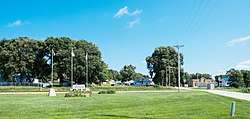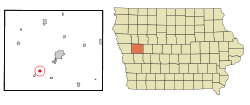Arion, Iowa
Arion is a city in Crawford County, Iowa, United States, along the Boyer River. The population was 108 at the 2010 census.
Arion, Iowa | |
|---|---|
 | |
 Location of Arion, Iowa | |
| Coordinates: 41°56′57″N 95°27′47″W | |
| Country | |
| State | |
| County | Crawford |
| Area | |
| • Total | 0.47 sq mi (1.23 km2) |
| • Land | 0.47 sq mi (1.23 km2) |
| • Water | 0.00 sq mi (0.00 km2) |
| Elevation | 1,152 ft (351 m) |
| Population | |
| • Total | 108 |
| • Estimate (2019)[3] | 107 |
| • Density | 225.26/sq mi (87.01/km2) |
| Time zone | UTC-6 (Central (CST)) |
| • Summer (DST) | UTC-5 (CDT) |
| ZIP code | 51520 |
| Area code(s) | 712 |
| FIPS code | 19-02755 |
| GNIS feature ID | 0454228 |
Geography
Arion is located at 41°56′57″N 95°27′47″W (41.949194, -95.462955).[5]
According to the United States Census Bureau, the city has a total area of 0.48 square miles (1.24 km2), all land.[6]
Demographics
| Year | Pop. | ±% |
|---|---|---|
| 1900 | 192 | — |
| 1910 | 168 | −12.5% |
| 1920 | 242 | +44.0% |
| 1930 | 269 | +11.2% |
| 1940 | 271 | +0.7% |
| 1950 | 220 | −18.8% |
| 1960 | 201 | −8.6% |
| 1970 | 199 | −1.0% |
| 1980 | 207 | +4.0% |
| 1990 | 148 | −28.5% |
| 2000 | 136 | −8.1% |
| 2010 | 108 | −20.6% |
| 2019 | 107 | −0.9% |
| Source:"U.S. Census website". United States Census Bureau. Retrieved 2020-03-28. and Iowa Data Center Source: | ||
2010 census
As of the census[2] of 2010, there were 108 people, 43 households, and 26 families living in the city. The population density was 225.0 inhabitants per square mile (86.9/km2). There were 48 housing units at an average density of 100.0 per square mile (38.6/km2). The racial makeup of the city was 90.7% White, 6.5% from other races, and 2.8% from two or more races. Hispanic or Latino of any race were 8.3% of the population.
There were 43 households of which 27.9% had children under the age of 18 living with them, 48.8% were married couples living together, 9.3% had a female householder with no husband present, 2.3% had a male householder with no wife present, and 39.5% were non-families. 30.2% of all households were made up of individuals and 11.6% had someone living alone who was 65 years of age or older. The average household size was 2.51 and the average family size was 3.00.
The median age in the city was 38 years. 25% of residents were under the age of 18; 6.6% were between the ages of 18 and 24; 24.9% were from 25 to 44; 31.5% were from 45 to 64; and 12% were 65 years of age or older. The gender makeup of the city was 53.7% male and 46.3% female.
2000 census
As of the census[8] of 2000, there were 136 people, 56 households, and 38 families living in the city. The population density was 286.4 people per square mile (111.7/km2). There were 61 housing units at an average density of 128.4 per square mile (50.1/km2). The racial makeup of the city was 92.65% White, 0.74% Native American, 3.68% from other races, and 2.94% from two or more races. Hispanic or Latino of any race were 8.09% of the population.
There were 56 households out of which 32.1% had children under the age of 18 living with them, 44.6% were married couples living together, 7.1% had a female householder with no husband present, and 32.1% were non-families. 25.0% of all households were made up of individuals and 1.8% had someone living alone who was 65 years of age or older. The average household size was 2.43 and the average family size was 2.71.
22.8% are under the age of 18, 10.3% from 18 to 24, 30.1% from 25 to 44, 25.7% from 45 to 64, and 11.0% who were 65 years of age or older. The median age was 38 years. For every 100 females, there were 106.1 males. For every 100 females age 18 and over, there were 118.8 males.
The median income for a household in the city was $33,750, and the median income for a family was $36,250. Males had a median income of $26,250 versus $18,750 for females. The per capita income for the city was $12,654. There were 23.3% of families and 27.7% of the population living below the poverty line, including 38.6% of under eighteens and 50.0% of those over 64.
Education
Boyer Valley Community School District operates public schools serving the community.[9] It was a part of the Dow City-Arion Community School District until July 1, 1994, when it merged into the Boyer Valley district.[10]
References
- "2019 U.S. Gazetteer Files". United States Census Bureau. Retrieved July 17, 2020.
- "U.S. Census website". United States Census Bureau. Retrieved 2012-05-11.
- "Population and Housing Unit Estimates". United States Census Bureau. May 24, 2020. Retrieved May 27, 2020.
- Chicago and North Western Railway Company (1908). A History of the Origin of the Place Names Connected with the Chicago & North Western and Chicago, St. Paul, Minneapolis & Omaha Railways. p. 38.
- "US Gazetteer files: 2010, 2000, and 1990". United States Census Bureau. 2011-02-12. Retrieved 2011-04-23.
- "US Gazetteer files 2010". United States Census Bureau. Archived from the original on 2012-01-25. Retrieved 2012-05-11.
- "Census of Population and Housing". Census.gov. Retrieved June 4, 2015.
- "U.S. Census website". United States Census Bureau. Retrieved 2008-01-31.
- "Boyer Valley." Iowa Department of Education. Retrieved on July 16, 2018.
- "REORGANIZATION & DISSOLUTION ACTIONS SINCE 1965-66 Archived 2019-02-09 at the Wayback Machine." Iowa Department of Education. Retrieved on July 20, 2018.